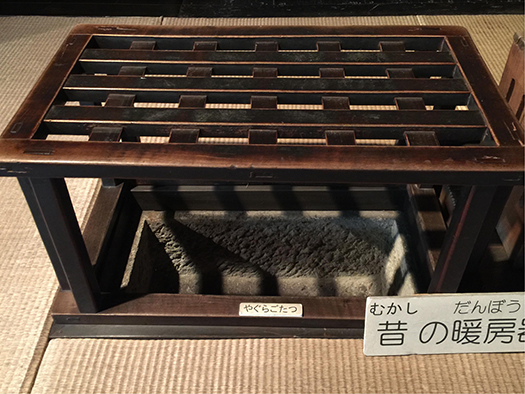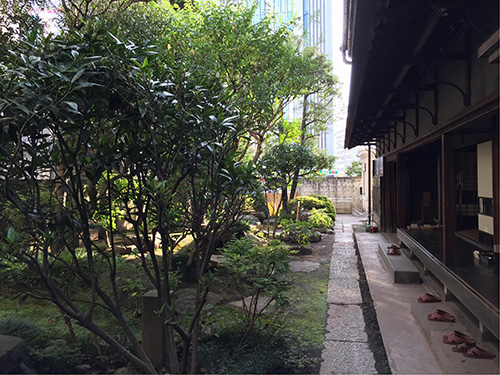

さて宇都宮の商家建築・旧篠原邸、最終回です。
写真は宇都宮の豪商家の「暖房設備」。
明治28年と言えば、すでに北海道ではストーブが普及していたけれど、
北関東での最先端住宅でも炬燵が主たる「採暖」装置。
北海道ではとても炬燵では寒冷対策は用をなさなかったので、
炬燵というのは生まれてから一度もわたしは体感がありません。
一度くらいは入ったかも知れないけれど記憶がない(笑)。
ただ、この家では大谷石の外壁被覆もあり、その下地としての
塗り壁の重厚さもあったので、一定の「気密性」が感じられる。
こういう住宅で果たしてどんな室内気候であったか、
興味は尽きない部分がありますね。今後、関東での活動が再開できたら
もう一度、再訪してみたいと思っております。
ずいぶん写真を撮影していたようで、全部で50-60枚ほどあった。
取材体験と写真を元に再調査をしていくとどんどん事実が出てくる。
まことに「深掘り型」のコロナ禍逆利用古民家再発掘。
こういうのはこれでまた新しい「住宅取材」構成のあり方かも知れません。
ブログという表現手段での住宅テーマの掘り下げ方法。
住宅性能という切り口での視角も持って見返してみるとリアリティが高まる。
たぶんありがちな「浪漫的」ノスタルジック側面からだけの見方とは
やや違う視点での見返しが可能なのだと気付かされますね。
今回の宇都宮商家も、防火性能とその実際例としての空襲での現実を
掘り起こして考えて行くと、先人の工夫の重さが見え息づかいが伝わる。
防火「性能」要件についてはいろいろ掘り起こせるけれど、
「あたたかさ」の追究についてはやはり対応工法開発以前の状況そのまま。
しかし現実の暮らしでは「少しでも」という知恵の痕跡も見えるので興味深い。

家の作り方で冬の寒さに対して打開策があり得るという考え方が
そもそも作り手の側になかったのがごく最近まで。
この列島での四季変化のなかで日本人は連綿と生き続けてきた。
冬の寒さというものが克服される方法の開発自体が、ここ数十年に過ぎない。
それまでは明治・北海道開拓の必要性から一部で手法開発が
行われてきたに過ぎない。世界的にも冬の寒さを住宅の断熱で克服しようという
考え方そのものがそのツールであるグラスウール出現以降ともいえる。
しかし一方、たとえば高価な輸入ガラス建材の普及は北海道から始まった。
開拓者で厳しい経済状況の中でもそこはケチらなかった。
紙と木だけでは気密という概念は達成できないと本能的にわかったのでしょうね。
日本で生産がされない段階から特異的に北海道が先鞭を切った事実。
断熱工法が開発される以前から人々のごく自然な「建材選択」が先行した。
やはりこの面の「住宅革命」を揺籃した地域であると自覚できます。
English version⬇
[Utsunomiya 126-year-old heater / Japanese good house ㉝-10]
By the way, this is the final episode of the former Shinohara residence, a commercial building in Utsunomiya.
The photo is the “heating equipment” of a wealthy merchant house in Utsunomiya.
Speaking of Meiji 28, stoves were already widespread in Hokkaido,
Kotatsu is the main “warming” device even in the most advanced houses in the northern Kanto region.
In Hokkaido, Kotatsu didn’t use any measures against cold, so
I have never experienced Kotatsu since I was born.
I may have entered it once, but I don’t remember (laughs).
However, in this house, there is also an outer wall covering of Oya stone, and as a base for it
There was also a heavy plastered wall, so a certain degree of “airtightness” can be felt.
What kind of indoor climate was it in such a house?
There is a part that I’m not completely interested in. If we can resume activities in Kanto in the future
I would like to visit again.
It seems that he was taking a lot of pictures, and there were about 50-60 in total.
Facts will come out more and more as we re-examine based on the interview experience and photos.
Indeed, “deep digging type” corona reversal use old folk house re-excavation.
This may be a new way of “housing coverage” composition.
How to delve into the housing theme with the expression means of blog.
If you look back at the perspective of housing performance, the reality will increase.
Perhaps the usual “romantic” nostalgic side-only view
You realize that it is possible to look back from a slightly different perspective.
The Utsunomiya merchant house this time also has fire protection performance and the reality of air raids as a practical example.
When you dig up and think about it, you can see the weight of the ingenuity of the ancestors and feel the breath.
We can dig up a lot about fire protection “performance” requirements,
Regarding the pursuit of “warmth”, the situation before the development of the corresponding construction method remains the same.
However, in real life, it is interesting because you can see traces of wisdom that “even a little”.
The idea that there can be a breakthrough against the cold of winter in how to make a house
Until very recently, it wasn’t on the side of the creator in the first place.
The Japanese have continued to live in the four seasons of this archipelago.
The development of ways to overcome the cold of winter has only been in the last few decades.
Until then, some methods were developed due to the need to develop the Meiji and Hokkaido regions.
It has only been done. Globally trying to overcome the cold of winter with heat insulation of houses
It can be said that the idea itself is after the advent of glass wool, which is the tool.
However, on the other hand, for example, the spread of glass building materials used expensive imported materials from Hokkaido.
It was a pioneer and was not stingy even in a difficult economic situation.
You must have instinctively realized that the concept of airtightness cannot be achieved with paper and wood alone.
The fact that Hokkaido took the lead specifically from the stage when it was not produced in Japan.
Even before the development of the heat insulation method, people’s natural “selection of building materials” preceded.
After all, you can realize that it is an area that has shaken the “housing revolution” in this aspect.
Posted on 6月 11th, 2021 by 三木 奎吾
Filed under: 住宅マーケティング, 日本社会・文化研究







コメントを投稿
「※誹謗中傷や、悪意のある書き込み、営利目的などのコメントを防ぐために、投稿された全てのコメントは一時的に保留されますのでご了承ください。」
You must be logged in to post a comment.